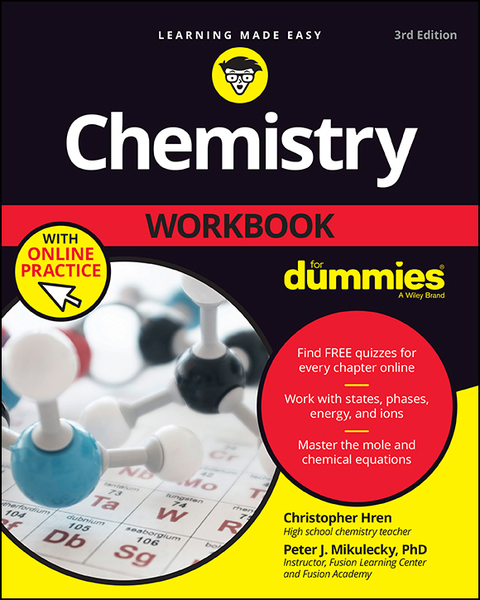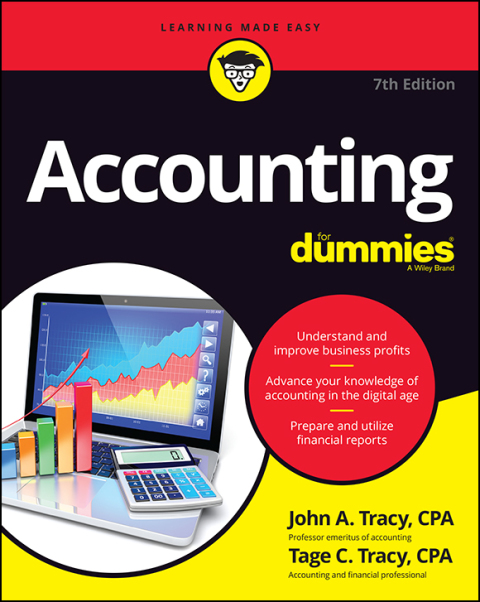Description
Efnisyfirlit
- Cover
- Introduction
- About This Book
- Foolish Assumptions
- Icons Used in This Book
- Beyond the Book
- Where to Go from Here
- Part 1: Getting Cozy with Numbers, Atoms, and Elements
- Chapter 1: Noting Numbers Scientifically
- Using Exponential and Scientific Notation to Report Measurements
- Multiplying and Dividing in Scientific Notation
- Using Exponential Notation to Add and Subtract
- Distinguishing between Accuracy and Precision
- Expressing Precision with Significant Figures
- Doing Arithmetic with Significant Figures
- Answers to Questions on Noting Numbers Scientifically
- Chapter 2: Using and Converting Units
- Familiarizing Yourself with Base Units and Metric System Prefixes
- Building Derived Units from Base Units
- Converting between Units: The Conversion Factor
- Letting the Units Guide You
- Answers to Questions on Using and Converting Units
- Chapter 3: Breaking Down Atoms
- The Atom: Protons, Electrons, and Neutrons
- Deciphering Chemical Symbols: Atomic and Mass Numbers
- Accounting for Isotopes Using Atomic Masses
- Answers to Questions on Atoms
- Chapter 4: Surveying the Periodic Table of the Elements
- Organizing the Periodic Table into Periods and Groups
- Predicting Properties from Periodic and Group Trends
- Seeking Stability with Valence Electrons by Forming Ions
- Putting Electrons in Their Places: Electron Configurations
- Measuring the Amount of Energy (or Light) an Excited Electron Emits
- Answers to Questions on the Periodic Table
- Part 2: Making and Remaking Compounds
- Chapter 5: Building Bonds
- Pairing Charges with Ionic Bonds
- Sharing Electrons with Covalent Bonds
- Occupying and Overlapping Molecular Orbitals
- Polarity: Sharing Electrons Unevenly
- Shaping Molecules: VSEPR Theory and Hybridization
- Answers to Questions on Bonds
- Chapter 6: Naming Compounds and Writing Formulas
- Labeling Ionic Compounds and Writing Their Formulas
- Getting a Grip on Ionic Compounds with Polyatomic Ions
- Naming Molecular (Covalent) Compounds and Writing Their Formulas
- Addressing Acids
- Mixing the Rules for Naming and Formula Writing
- Beyond the Basics: Naming Organic Carbon Chains
- Answers to Questions on Naming Compounds and Writing Formulas
- Chapter 7: Understanding the Many Uses of the Mole
- The Mole Conversion Factor: Avogadro’s Number
- Doing Mass and Volume Mole Conversions
- Determining Percent Composition
- Calculating Empirical Formulas
- Using Empirical Formulas to Find Molecular Formulas
- Answers to Questions on Moles
- Chapter 8: Getting a Grip on Chemical Equations
- Translating Chemistry into Equations and Symbols
- Balancing Chemical Equations
- Recognizing Reactions and Predicting Products
- Canceling Spectator Ions: Net Ionic Equations
- Answers to Questions on Chemical Equations
- Chapter 9: Putting Stoichiometry to Work
- Using Mole-Mole Conversions from Balanced Equations
- Putting Moles at the Center: Conversions Involving Particles, Volumes, and Masses
- Limiting Your Reagents
- Counting Your Chickens after They’ve Hatched: Percent Yield Calculations
- Answers to Questions on Stoichiometry
- Part 3: Examining Changes in Terms of Energy
- Chapter 10: Understanding States in Terms of Energy
- Describing States of Matter with the Kinetic Molecular Theory
- Make a Move: Figuring Out Phase Transitions and Diagrams
- Answers to Questions on Changes of State
- Chapter 11: Obeying Gas Laws
- Boyle’s Law: Playing with Pressure and Volume
- Charles’s Law and Absolute Zero: Looking at Volume and Temperature
- The Combined and Ideal Gas Laws: Working with Pressure, Volume, and Temperature
- Mixing It Up with Dalton’s Law of Partial Pressures
- Diffusing and Effusing with Graham’s Law
- Answers to Questions on Gas Laws
- Chapter 12: Dissolving into Solutions
- Seeing Different Forces at Work in Solubility
- Concentrating on Molarity and Percent Solutions
- Changing Concentrations by Making Dilutions
- Altering Solubility with Temperature
- Answers to Questions on Solutions
- Chapter 13: Playing Hot and Cold: Colligative Properties
- Portioning Particles: Molality and Mole Fractions
- Too Hot to Handle: Elevating and Calculating Boiling Points
- How Low Can You Go? Depressing and Calculating Freezing Points
- Determining Molecular Masses with Boiling and Freezing Points
- Answers to Questions on Colligative Properties
- Chapter 14: Exploring Rates and Equilibrium
- Measuring Rates
- Focusing on Factors That Affect Rates
- Measuring Equilibrium
- Answers to Questions on Rates and Equilibrium
- Chapter 15: Warming Up to Thermochemistry
- Understanding the Basics of Thermodynamics
- Working with Specific Heat Capacity and Calorimetry
- Absorbing and Releasing Heat: Endothermic and Exothermic Reactions
- Summing Heats with Hess’s Law
- Answers to Questions on Thermochemistry
- Part 4: Swapping Charges
- Chapter 16: Working with Acids and Bases
- Surveying Three Complementary Methods for Defining Acids and Bases
- Measuring Acidity and Basicity: pH, pOH, and KW
- Ka and Kb: Finding Strength through Dissociation
- Answers to Questions on Acids and Bases
- Chapter 17: Achieving Neutrality with Titrations and Buffers
- Concentrating on Titration to Figure Out Molarity
- Maintaining Your pH with Buffers
- Measuring Salt Solubility with Ksp
- Answers to Questions on Titrations and Buffers
- Chapter 18: Accounting for Electrons in Redox
- Oxidation Numbers: Keeping Tabs on Electrons
- Balancing Redox Reactions under Acidic Conditions
- Balancing Redox Reactions under Basic Conditions
- Answers to Questions on Electrons in Redox
- Chapter 19: Galvanizing Yourself to Do Electrochemistry
- Identifying Anodes and Cathodes
- Calculating Electromotive Force and Standard Reduction Potentials
- Coupling Current to Chemistry: Electrolytic Cells
- Answers to Questions on Electrochemistry
- Chapter 20: Doing Chemistry with Atomic Nuclei
- Decaying Nuclei in Different Ways
- Measuring Rates of Decay: Half-Lives
- Making and Breaking Nuclei: Fusion and Fission
- Answers to Questions on Nuclear Chemistry
- Part 5: The Part of Tens
- Chapter 21: Ten Chemistry Formulas to Tattoo on Your Brain
- The Combined Gas Law
- Dalton’s Law of Partial Pressures
- The Dilution Equation
- Rate Laws
- The Equilibrium Constant
- Free Energy Change
- Constant-Pressure Calorimetry
- Hess’s Law
- pH, pOH, and KW
- Ka and Kb
- Chapter 22: Ten Annoying Exceptions to Chemistry Rules
- Hydrogen Isn’t an Alkali Metal
- The Octet Rule Isn’t Always an Option
- Some Electron Configurations Ignore the Orbital Rules
- One Partner in a Coordinate Covalent Bond Giveth Electrons; the Other Taketh
- All Hybridized Orbitals Are Created Equal
- Use Caution When Naming Compounds with Transition Metals
- You Must Memorize Polyatomic Ions
- Liquid Water Is Denser than Ice
- No Gas Is Truly Ideal
- Common Names for Organic Compounds Hearken Back to the Old Days
- About the Authors
- Connect with Dummies
- End User License Agreement






Reviews
There are no reviews yet.